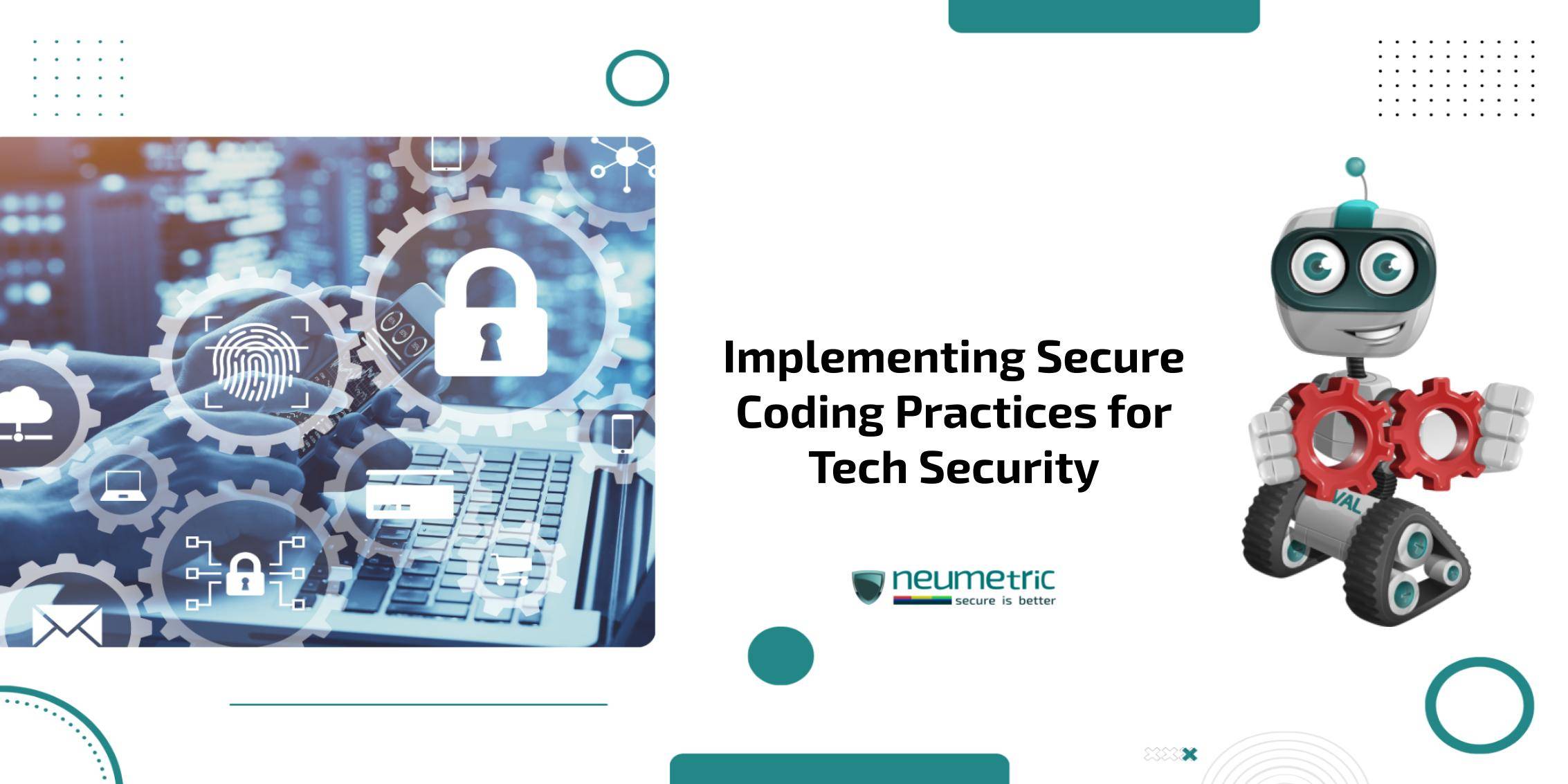Table of Contents
ToggleImplementing Secure Coding Practices in TechSec
Introduction
Secure coding is the art & science of writing computer programs in a way that protects them from security threats & vulnerabilities. It involves adopting coding practices that prioritize the confidentiality, integrity & availability of data throughout the software development lifecycle.
In the rapidly evolving landscape of technology, where the digital realm intertwines with every aspect of our lives, the significance of secure coding practices cannot be overstated. As technology advances, so do the methods & sophistication of cyber threats. Secure coding serves as the first line of defense against potential exploits, ensuring the robustness & reliability of software applications.
The digital ecosystem is constantly under siege from malicious actors seeking to exploit vulnerabilities in software. Cyber threats range from common issues, like phishing attacks, to more sophisticated techniques such as zero-day vulnerabilities. An understanding of the evolving threat landscape underscores the urgency for developers to embrace secure coding practices, providing a proactive shield against emerging risks.
Understanding the Basics of Secure Coding Practices in TechSec
Secure coding extends beyond merely preventing unauthorized access. It encompasses a holistic approach that considers the entire software development process, from design to deployment. This approach emphasizes the identification & mitigation of potential security risks at every stage, ensuring that applications are resilient to various forms of attacks.
Common Threats Addressed by Secure Coding
- Code Injection: Code injection attacks, including SQL injection & command injection, occur when an attacker injects malicious code into a program. Secure coding practices mitigate this threat by validating & sanitizing inputs, ensuring that the application only processes legitimate data.
- Cross-Site Scripting: XSS attacks involve injecting malicious scripts into web applications, which are then executed by unsuspecting users. Secure coding mitigates XSS by validating user inputs, using output encoding & adopting secure coding patterns that minimize the risk of script injection.
- Cross-Site Request Forgery [CSRF]: CSRF exploits trust between a user’s browser & a website, tricking the user into performing unintended actions. Secure coding defends against CSRF by implementing anti-CSRF tokens, validating & authenticating requests & designing applications to resist such manipulations.
- SQL Injection: SQL injection attacks manipulate a database by injecting malicious SQL queries. Secure coding practices prevent SQL injection by using parameterized queries, stored procedures & input validation to ensure that user input does not interfere with the intended database operations.
Real-world Consequences of Insecure Coding: Insecure coding can lead to catastrophic consequences, ranging from unauthorized access to sensitive data to service disruptions & financial losses. Real-world examples, such as data breaches & system compromises, underscore the need for developers to prioritize secure coding to safeguard both user & organizational interests.
Key Principles of Secure Coding
- The principle of least privilege advocates providing only the minimum level of access or permissions necessary for a system or user to perform their tasks. By limiting access rights, secure coding minimizes the potential damage that can occur in the event of a security breach.
- Input validation ensures that data entered by users meets specific criteria before being processed. By validating inputs, secure coding prevents malicious data from being processed, reducing the risk of code injection & other related attacks.
- Output encoding involves converting potentially dangerous characters into a safe format before rendering them in a user interface. This prevents script injection attacks like XSS by ensuring that user-generated content is treated as data rather than executable code.
- Secure coding emphasizes robust authentication processes to verify the identity of users & strict authorization mechanisms to control their access privileges. Implementing strong authentication & authorization protocols reduces the risk of unauthorized access & privilege escalation.
- Effective error handling & logging mechanisms are essential components of secure coding. By providing informative error messages to developers & logging relevant information, secure coding practices aid in identifying & addressing security issues, enhancing the overall resilience of the application.
Secure Coding Best Practices
Selecting the right development framework lays the groundwork for secure coding. Opting for frameworks with built-in security features can provide a solid foundation, reducing the need for developers to reinvent the security wheel. Frameworks like Spring for Java or Django for Python often come equipped with security mechanisms that, when properly utilized, bolster the overall resilience of your applications.
Regularly Updating Dependencies & Libraries: In the ever-shifting landscape of cybersecurity, staying on top of updates is paramount. Regularly updating dependencies & libraries ensures that your application is fortified against the latest known vulnerabilities. Tools like Dependabot or Snyk can help automate the process, making it easier for development teams to stay vigilant without getting bogged down in manual updates.
Code Reviews & Static Code Analysis: Human eyes & automated tools working in tandem are a potent combination for secure coding. Regular code reviews provide an opportunity for developers to catch security issues early. Additionally, incorporating static code analysis tools, such as SonarQube or Checkmarx, into your development pipeline allows for the automatic detection of potential vulnerabilities, enhancing the overall code quality.
Continuous Integration/Continuous Deployment Security: The integration of security into the CI/CD pipeline is a game-changer. Embedding security checks into every phase of development ensures that potential vulnerabilities are identified & addressed swiftly. Tools like Jenkins, GitLab CI or GitHub Actions can be configured to run security scans as an integral part of the deployment process, promoting a proactive approach to security.
Secure Coding in Different Programming Languages
- Secure Coding Practices in Java: Java’s widespread use necessitates robust security practices. Sanitizing user inputs, utilizing secure authentication mechanisms & leveraging built-in security features such as Java’s Security Manager contribute to creating secure Java applications.
- Secure Coding Practices in Python: Python’s readability shouldn’t overshadow security concerns. Practices such as input validation, secure handling of file operations & using frameworks like Flask with its built-in security features are crucial for developing secure Python applications.
- Secure Coding Practices in C/C++: Memory management in C/C++ opens the door to potential vulnerabilities. Secure coding involves proper use of pointers, bounds checking & adopting functions like ‘strncpy’ instead of ‘strcpy’ to prevent buffer overflows & other memory-related vulnerabilities.
- Secure Coding Practices in JavaScript: As the language powering dynamic web content, JavaScript requires vigilant security practices. Sanitizing user inputs, using secure coding libraries like DOMPurify to prevent XSS & adhering to Content Security Policy [CSP] guidelines are imperative for secure JavaScript development.
Tools & Technologies for Secure Coding
Static Analysis Tools: Static analysis tools, such as ESLint for JavaScript or FindBugs for Java, analyze code without executing it. These tools identify potential vulnerabilities & coding errors early in the development process, promoting a proactive approach to security.
Dynamic Analysis Tools for Security: Dynamic analysis tools, like OWASP ZAP or Burp Suite, interact with running applications to identify security vulnerabilities in real-time. Integrating these tools into your testing process provides insights into how applications behave under different conditions.
Dependency Scanning Tools: Dependency scanning tools, such as OWASP Dependency-Check, automatically identify & alert developers to known vulnerabilities in third-party libraries. This ensures that potential risks from dependencies are mitigated, bolstering the overall security posture of the application.
Integration of Security Testing in DevOps Pipeline: Integrating security testing seamlessly into the DevOps pipeline ensures that security is not an afterthought. Tools like SonarQube, Fortify or Veracode can be integrated into the CI/CD pipeline, allowing for automated security assessments with every code change.
The Role of Code Documentation in Security
Documenting Security Requirements: Documenting security requirements acts as a roadmap for developers, outlining the specific security measures & considerations that must be addressed during the development process. This not only ensures that everyone is on the same page but also serves as a valuable reference point for future assessments & audits.
Creating Secure Coding Guidelines & Manuals: Establishing secure coding guidelines & manuals provides a standardized approach for your development team. This includes best practices, coding conventions & specific security measures to follow. By having a go-to resource, developers can navigate potential pitfalls & make informed decisions, promoting a unified & secure coding culture.
Conclusion
Security is not a one-time affair; it’s a mindset that should permeate every line of code. Encouraging a culture of security within development teams is crucial. This involves fostering awareness, conducting regular training sessions & embedding security considerations into the development ethos. When security becomes a shared responsibility & a core value, it transforms from a checklist item into an integral part of the development DNA.
In the dynamic realm of technology, stagnation is the enemy of security. The landscape is ever-evolving & so must our approach to secure coding. Continuous learning, staying updated on emerging threats & adapting coding practices accordingly are essential. This involves not only keeping an eye on new tools & technologies but also actively participating in the broader security community. By acknowledging that the pursuit of security is a perpetual journey, development teams position themselves to face the challenges of tomorrow with resilience & adaptability.
FAQ
Why is secure coding essential in today’s tech landscape & how does it protect against real-world consequences?
By following secure coding practices, we create robust software that stands guard against real-world consequences like data breaches, unauthorized access & potential financial losses. It’s not just about writing code; it’s about building a defense mechanism for the digital age.
How can my development team establish a culture of security & why is it important for the long-term resilience of our applications?
Establishing a culture of security within your development team is like cultivating a mindset that prioritizes the safeguarding of your digital creations. It involves regular training, fostering awareness & integrating security considerations into every aspect of the development process. This culture is not just a checkbox; it’s a long-term investment in the resilience of your applications. When security becomes ingrained in your team’s DNA, it transforms from a task to a shared responsibility, ensuring your applications can stand the test of time.
Can you explain the significance of documentation & guidelines in secure coding & how do they contribute to building more secure applications?
Documentation & guidelines play a pivotal role in the secure coding journey. When you document security requirements, you provide a roadmap for developers, ensuring a unified understanding of the measures needed to fortify your code. Creating secure coding guidelines & manuals establishes a standardized approach, offering developers a go-to resource for best practices & coding conventions. Together, these documentation practices contribute to building more secure applications by promoting consistency, clarity & a shared understanding of security measures throughout the development process.





